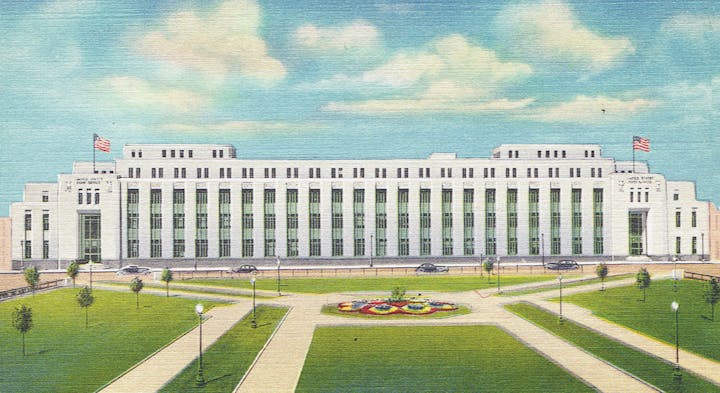Thanks to Minneapolis Mayor Jacob Frey's recent press conference about the future of riverfront development, urbanists of all stripes are reconsidering the downtown post office. Everyone agrees it should be reconnected to downtown.
Well, it once was connected, but downtown wasn't particularly interested.
That's back when the area along the west side of the Mississippi River was tired and sooty. A big warehouse, some class-C office space, some two-story retail, a flophouse or three. When it opened in 1934, the new post office was certainly impressive, but it never had the draw of a theater or department store. Despite its stunning interior, a post office, after all, is a place of everyday commerce, a place where you have to go, not necessarily want to go.
On paper, the post office project looked noble and inspirational, sort of an early example of urban renewal. Where old brick commercial buildings had once crowded the street, there was now a broad new wall of a building in the severe, rational style of the era.
The architect was Léon Eugène Arnal, who'd been the lead on the Foshay Tower a few years earlier. If that building's interior was the last draught of fizzy Art Deco aesthetics, tipsy and frivolous, the new post office was a serious statement of power and confidence.
The post office faced a sizable park: an entire block of grass and trees standing in line like soldiers. Two pairs of sidewalks led to an octagonal flower bed in the center of the park; from the flower bed, diagonal walkways opened like arms to embrace the post office.
Early proposals for the post office called for a monument in the center of the park, with stylized American Indians, settlers and pioneer women around an obelisk topped by an eagle. That monument was never built.
In 1936, however, the park became the home for a gift from the Pillsbury family: a statue called "Pioneers." Three generations hewn from granite, staring hard into the distance. The statue gave the park its name: Pioneer Square.
For a while, it must have given the area an unpretentious charm. The park was serviceable. The buildings around, while old, made up a pleasant-enough tableau of old and older, small and tall. It was the textbook definition of a place the postwar urbanists would erase. The city didn't need old buildings and an underused park. The city needed parking.
Pioneer Square is long gone. The statue was hauled off in 1967 and relocated in Northeast. The Churchill Apartments — a 33-story structure completed in 1981 — blocks off any chance to see the post office as a whole.
There are more residential units in the area, including the River Towers condos — these tall, rote 16- and 27-story slabs on the graveyard of the Gateway were finished in 1965. And there's new housing on Washington Avenue, too.
But for all the residents, the area feels underpopulated, and that's what the new proposals seek to fix.
A good design, a market, a hotel. That'll do it. Right?
But what if it's unfixable?
Reconnecting downtown to the Mississippi is a good idea. And in some places along the river, we're doing that already. The Mill Ruins, the Stone Arch Bridge, Gold Medal Park have brought the riverfront a long way from the days of industrial ruins and disuse. There's even a waterfront park to the north of the post office, by the Federal Reserve Bank, although it's not overly thronged or overly attractive.
The people envisioning a new future for the post office hope it will tie together the Downtown East segment of the river with the area north of Hennepin. The proposals displayed at the press conference were University of Minnesota student projects, blue-sky reimagining of the site. Most share the same idea: People will go to the post office site and walk down to the river, stroll around various plazas, and perhaps take selfies. It would be very nice.
But it's likely that the post office will never be particularly popular. The action will always be down at the Stone Arch Bridge. Best to have modest expectations, perhaps. If the post office is decommissioned and redeveloped, a mix of office space and residential, with the obligatory hotel (it seems we can't have too many boutique hotels) may keep the site alive and reasonably populated.
But the post office can't help downtown connect with the river. Its entire design was intended to accomplish the opposite, to be a wall between the city and the gritty banks of the Mississippi. It's caught between the 3rd Avenue Bridge, which seems to form a subconscious boundary to the East Bank's river development, and Hennepin Avenue.
The post office must be saved, of course. But it's not a savior.
One of the U of M students suggested creating a postal museum inside the post office. No offense to philatelists, but it's unlikely that tourists would pour in, even if the museum had interactive exhibits and touchscreens that let you look at old wanted posters.
The main hall is a gorgeous vault of buttery stone, stark black granite and Moderne designs. Left exactly as it is, it will be a postal museum. It's also a time capsule the likes of which few cities can boast: an untouched example of everyday life in the Depression, a gleaming hall of gold in a time of lead and cement.
We were supposed to have admired the Minneapolis post office from a park, but that's gone. The building is now a stage without an audience. Now we're supposed to use it as a means to enjoy the river that it was built to shield people from.
It's not the best situation, but at least we're debating what to do with it, not how to replace it. As its builders might have said when they first threw open its doors and let people marvel at the beauty within: This is called progress.








